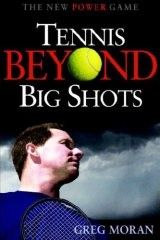May 2006 Article
Mortal Tennis/Circle Game Archive
Tennis Server
|

 |
Tennis players come in all shapes and sizes as well as varying styles of play: Some live on the baseline while others charge the net at every opportunity. Many today use Western grips while some still favor the Eastern approach. We see the "modern game" open stance while others prefer the more traditional closed approach. No two players look alike on or off the court yet there is one technique which every good tennis player in the world utilizes that, if you incorporate into your game, will take you to the next level faster than you can say Martina Navratilova. As I've written many times, I feel that, once a player has developed a good feel for the basics of the game, footwork becomes the most important part of tennis. I was very happy a few weeks ago to hear tennis commentator Mary Carillo comment on television that many people think that tennis is a "hitting" game when in fact it is a "moving" game. Now many teaching professionals will disagree with Mary and I, saying that the "stroke" is the most important part of the game. These pros will have their students take thousands of practice swings and shadow strokes to develop a rhythmic stroking pattern that could be on the cover of Tennis magazine. While sound stokes, that will hold up under the pressure of an intense match, are certainly important, I've always felt that they're useless if you can't get into position to execute them. Lots of players have great strokes in the clubhouse lobby or locker room mirror room only to see those stokes deteriorate into a mass of contortion and compensations once they actually have to move their feet and get to the ball. Positioning and balance are the keys to executing controlled strokes and the secret to both lies in the moment before your opponent strikes the ball. The next time you get a chance to watch the pros on television, or even the top players at your club, shift your eyes downward, so that you're focused solely on their feet. You'll notice that, every now and then, they jump up into the air. This jump is called a split-step and is, in my opinion, what separates the players from the pretenders. The split-step is a small hop (an inch or two off the court), timed so that you are in the air as your opponent strikes the ball. When you lift both feet off the ground, you unweight your body and, while in the air, you'll see where your opponent's shot is going. As you touch down, with you feet approximately 1-2 feet apart and your knees slightly bent, immediately spring off in the direction of your opponent's oncoming shot. At the same time, turn your shoulders and hips towards the ball, which will begin your racket preparation. The next time you take the court focus on taking a split step every time your opponent's racket begins its forward motion towards the ball. A good tip to get yourself into the habit was given to me by Geoff Norton, one of the world's top teaching professionals. Geoff has his students actually say the word "split" out loud, at the appropriate time, to remind themselves to split step before every shot their opponents hit. You may find the timing a bit difficult at first but keep working on it and, in a short while, you'll find that you're reacting significantly faster to your opponent's shots and you'll feel as if you have all day to prepare for your shot. All--I repeat, all--good players split step before every shot!
This column is copyrighted by Greg Moran, all rights reserved.
Greg Moran is the Head Professional at the Four Seasons Racquet Club in Wilton, Connecticut. He is a former ranked junior and college player and certified by both the USPTA and USPTR. Greg has written on a wide variety of tennis-related subjects for numerous newspapers and tennis publications including Tennis, Tennis Match and Court Time magazines. He is also a member of the FILA and WILSON Advisory Staffs.
Questions and comments about these columns can be directed to Greg by using this form.
|



October 2022 Tennis Anyone: Patterns in Doubles by John Mills. September 2022 Tennis Anyone: Short Court by John Mills. |

 You will join 13,000 other subscribers in receiving news of updates to the Tennis Server along with monthly tennis tips from tennis pro Tom Veneziano.
You will join 13,000 other subscribers in receiving news of updates to the Tennis Server along with monthly tennis tips from tennis pro Tom Veneziano. 